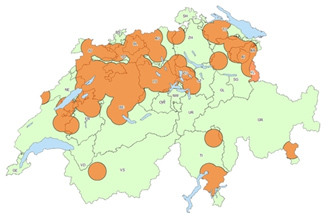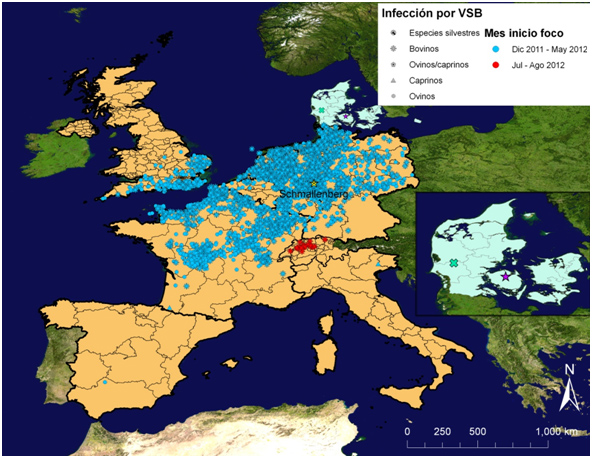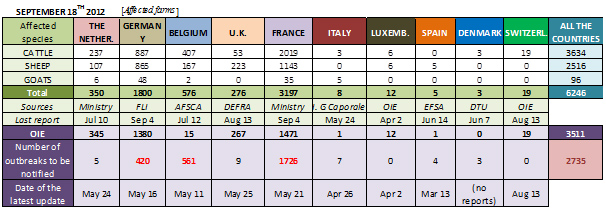Second SBV wave
Víctor Rodríguez Prieto & José Manuel Sánchez-Vizcaíno
October 1st, 2012. SUAT-UCM
The second season of Schmallenberg disease has begun.
In the first epidemic wave Schmallenberg virus (SBV) infection affected eight countries in the European Union: Germany (December 2011), Netherlands (December 2011), Belgium (December 2011), United Kingdom (January 2012), France (January 2012), Italy(February 2012), Luxembourg (February 2012) and Spain (March 2012). Though the end of the season was declared to be at the end of May 2012, Denmark declared the first fetus affected by the SBV infection in June in the island of Funen (Figure 1, detail), while some weeks before antibodies against the virus were found in cattle in Jutland (Figure 1, detail). Moreover, the virus was detected in pools of midges of the genus Culicoides (species unknown yet) caught in October 2011, which means SBV has been circulating in very northern latitudes.
Fig. 1. Map of western Europe which shows the location of the 3,511 foci compatible with Schmallenberg virus infection (SBV) that have been notified to the OIE. The yellow star shows the location of the Schmallenberg city where the first positive samples were sent. The circles denote the outbreaks in sheep; the triangles mark the outbreaks in goats; the blades designated outbreaks in cattle; the pentagons represent the undefined foci for sheep or goats; the circles containing a deer indicate the outbreaks in wild animals. Figures in blue denote the foci from December 2011 to May 2012; red is used for the outbreaks from July-August 2012 (Source: self-elaboration from data of the OIE-WAHID database until August 14th, 2012). In detail, a purple star denotes the first outbreak in cattle in Denmark, and a blue cross the first seropositive animals in Jutland (Denmark).
Up to the moment that the notification of outbreaks was stopped, more than 3,500 foci were reported in ruminant premises. The most affected sectors were cattle (34.8%) and sheep (63.3%), with sporadic outbreaks in goats. Overall mortality did not reach values higher than 2%, even lower than 1%.
Despite the end of the OIE notifications, certain official organisms from each affected country have been reporting new SBV infection cases (Table 1), showing the great spread of the infection (affecting more than 6,200 farms in less than one year), as well as the important sub-notification of outbreaks to the OIE (in some countries there are more non-notified outbreaks than notified ones).
Table 1. Number of Schmallenberg disease outbreaks in the eight affected EU countries up to September 18th, 2012. Data come from notifications submitted by official organisms of each country, and are compared to the OIE information.
The only country reporting outbreaks through the OIE platform in this second epidemic wave is Switzerland, which declared more than 30 cases in 19 cattle farms during July-August 2012 (Figure 1). However, according to the Federal Veterinary Office 124 cattle farms with clinical cases have been detected positive to SBV up to date, either to the virus or antibodies (Figure 2) (FVO, 2012). So far only 6 malformations have occurred (FVO, 2012), though more cases are expected to appear during autumn, due to the rapid spread of the virus in the country so far. The spread is so unexpected that a case has been declared in the Graubunden canton, more than 1,000 meters above the sea level. This finding seems unusual, due to the “tropical” behavior of the involved vectors, the midges.

Fig. 2. Areas of Switzerland affected by the Schmallenberg virus.
Source: Swiss Federal Veterinary Office, updated on September 19th, 2012
During July 2012, several adult cows in Ukraine were observed to be affected by a disease compatible with the unspecified clinical symptoms of SBV infection, but the virus has not been found yet (ProMED-mail, 2012a).
In addition, the Austrian Agency for Health and Food Safety (AGES, 2012) has confirmed the presence of SBV in Austria. So far, 89% of the samples submitted have tested positive to SBV. However, neither clinical cases nor malformed fetus have been found so far. On October 1st, Dr. Kaba confirmed the presence of antibodies in 21 of the 230 goats tested in western Poland, near the German border (ProMED-mail, 2012b).
Moreover, the virus has been spreading in new regions of the first-season affected countries. Therefore, in September 2012 the first clinical cases in cattle were reported in the French region of Brittany (ProMED-mail, 2012c), characterized by its important dairy industry. At the same time, seropositive cattle and sheep were detected in Wales(ProMED-mail, 2012d), which has been free so far.
These first findings are not unexpected, since the virus had an incredible spread during the first season. However, the search of the virus in neighboring countries such as Ireland, Sweden, Hungary or the Balkans has been unfruitful so far, though attention should be paid to any compatible congenital malformation, especially in cattle or goats during October, since this is the date when the first affected lambs and kids of the season are expected.
The only “advantage” of being infected with SBV (compared to other emerging infectious diseases) is the immune protection acquired after the first exposure, tentatively good enough to prevent from future infections. This aspect, together with the low percentage of infected animals that suffered the disease, has caused the rejection of the disease to be included in the OIE list, due to its “minor impact” in livestock. However, it would be interesting to know how the virus is spreading during this second season (considered to be ended by May-June 2012) in both first-season affected and unaffected regions, as well as analyze the outbreak severity.
As for Spain, SBV infection could only be confirmed in five farms (EFSA, 2012). However, when compared to the situation in other countries, it seems evident that the SBV was circulating through the country subclinic or unapparently, though the later arrival of the virus to the country could partially explain the much lower number of cases. In addition, the most abundant midge species in Spain is the Culicoides imicola, whose role and competence for the SBV transmission is to be defined.
It seems very likely that in this second epidemic wave all the animals that were not in contact with the SBV during the first season are considered to be susceptible to the infection and its consequences this second time. Therefore, it would be advisable to implement all the surveillance and control actions in order to minimize the impact that new SBV outbreaks can cause.
References:
Agencia Austriaca de Salud y Seguridad Alimentaria (AGES) (2012). Infección de Schmallenberg identificada por primera vez en el ganado austriaco [alemán] (acceso el 1 de octubre de 2012).
Autoridad Europea de Seguridad Alimentaria (EFSA) (2012). "Schmallenberg" virus: Analysis of the Epidemiological Data and Assessment of Impact (acceso el 24 de septiembre de 2012).
Oficina Veterinaria Federal de Suiza (OVF) (2012).Virus de Schmallenberg (acceso el 19 de septiembre de 2012).
Organización Mundial de Sanidad Animal (OIE) (2012). Interfaz de la base de datos del sistema mundial de información zoosanitaria (WAHID) (acceso 18 de septiembre de 2012).
ProMED-mail (2012a). Undiagnosed illness, bovine - Ukraine: (VO) diarrhea, RFI. Número de archivo: 20120718.1205782.
ProMED-mail (2012b). Schmallenberg virus - Europe (61): Poland. Número de archivo: 20121001.1318740.
ProMED-mail (2012c). Schmallenberg virus (SBV) spreading in France. Número de archivo: 20120907.1285365.
ProMED-mail (2012d). UK (Wales) – 1st detected cases. Número de archive: 20120926.1310236.




